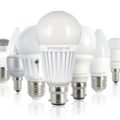If you’re a manager or supervisor, you may be responsible for the building where you work. Whether this is an office, shop, school, hotel, bar, restaurant, factory or storage facility, you need to be aware of the L2 Building Regulations. You also need to know how LED light bulbs can help you meet the law’s demands.
The aim of the regulations is to cut carbon emissions from new build commercial properties, and from extensions to existing buildings. By 2016, these emissions should be zero. This is where LED light bulbs can help.
To achieve zero emissions, the L2 Regulations lay down criteria for insulation, heating and lighting. It’s the last of these where you may be able to exert most control. And you can do this by using LED light bulbs.
For internal lighting, a building must have 55 lumens of light per watt of electricity used. If you use LED light bulbs on a 240-volt circuit, you can meet this requirement. For example, E14 LED light bulbs project 220 lumens of light and use three watts. This is the equivalent of 73 lumens per watt.
If your workplace installs a 12-volt lighting circuit for LED light bulbs, you can improve this still further. MR11 LED light bulbs consume 1.5 watts of power and give you 150 lumens of light. In other words, you can have 100 lumens per watt.
For display lighting, the L2 Regulations require a minimum efficiency of 15 lumens per watt. Again, LED light bulbs exceed this with ease.
LED light bulbs help you conserve power and stay within the L2 Regulations. They are also low maintenance, and last for up to 50,000 hours without any deterioration in quality. With LED light bulbs, you can’t go wrong.
Date: November 11, 2011
Tags: building buildings conservation fuel industry news non-domestic power regulations.
Learn how LED light bulbs can help your non-domestic building comply with the L2 Building Regulations for zero carbon emissions by 2016.




